Medium- and Long-Term Prediction of Airport Carbon Emissions under Uncertain Conditions Based on the LEAP Model
Abstract
:1. Introduction
2. Methods
2.1. Scope of Airport Carbon Emissions
2.2. LEAP-Airport Model
2.2.1. Model Framework
- i.
- Scenario-setting module: Considering the uncertainty of socioeconomic–epidemic factors and emission reduction measures, this module constructs uncertain scenarios of airport development. Socioeconomic parameters (SEPs) and epidemic parameters (EPs) are set through the socioeconomic–epidemic scenario-setting module, and abatement intensity parameters (AIPs) are set through the emission reduction scenario-setting module.
- ii.
- Data-processing module: In this module, the airport-throughput-forecasting module uses SEPs to forecast airport throughput. The emission reduction measure module outputs specific abatement measure parameters (AMPs) according to AIPs, such as application time, technology penetration, etc. The activity-level module integrates the predicted values of airport throughput and AMPs to calculate the airport activity level. The energy intensity module calculates energy intensity by combining base year data and AMPs.
- iii.
- LEAP model: Based on the activity level, energy intensity, and AMP data, the carbon emissions of the airport in the target year are predicted.
2.2.2. LEAP Model
2.2.3. Data-Processing Module
- i.
- Activity-level module
- ii.
- Energy intensity module
- iii.
- Airport-throughput-forecasting module
- i.
- It is assumed that no major emergencies (financial crisis, epidemic, etc.) occur within the forecast period;
- ii.
- It is assumed that CAN’s resources will always be able to meet the transportation demand within the forecast period;
- iii.
- It is assumed that within the predicted period, CAN continues to have a saturated capacity, and there is no substantial improvement in airspace conditions.
- iv.
- Emission reduction measure module
2.2.4. Scenario-Setting Module
- i.
- Socioeconomic–epidemic scenario-setting module
- ii.
- Emission reduction scenario-setting module
- iii.
- Scenario combination
3. Results and Discussion
3.1. Results of Airport Throughput Prediction
3.2. Activity-Level Prediction Results
3.3. Airport Carbon Emission Prediction Results
3.4. Analysis of Contribution Degree of Emission Reduction Measures
3.5. Distribution of Abatement Responsibilities among Airport Stakeholders
4. Conclusions and Policy Recommendations
- i.
- The intensity of airport carbon emission reduction measures should match the level of socioeconomic development. With the emission abatement efforts of the existing policies (EPS), the airport can achieve the carbon-peaking goal at a slow socioeconomic development intensity but will enter a plateau period at a rapid socioeconomic development intensity and cannot reach carbon peaking on time. On the basis of existing policies, increasing abatement efforts (LCS) can ensure that airports can realize the goal on time under all scenarios. Therefore, airport stakeholders should pay attention to various possible scenarios and plan the intensity of emission reduction measures in advance. Airport stakeholders can use the Carbon Peak Action Plan by 2030 [2] and the 14th Five-Year Plan for the Green Development of Civil Aviation [6] as guidance and determine the appropriate emission reduction intensity according to social and economic development.
- ii.
- Among the airport carbon emission reduction strategies, technological progress measures and alternative fuel measures have the greatest emission reduction potential. Special attention should be paid to the implementation of two types of emission reduction measures for aircraft, that is, actively promoting the application of high-efficiency aircraft engines while actively introducing SAFs. At present, Chinese airlines have achieved the first commercial flight using SAF [54] and should continue to accelerate the use of SAFs.
- iii.
- Among airport stakeholders, airlines are the most responsible party for emission reduction, accounting for more than 70% of the abatement responsibility. The airport’s emission reduction responsibility is about 20%, and the abatement responsibility of air traffic management bureaus is about 5%. However, the implementation of emission reduction measures responsible for airlines will face greater challenges, and the technology responsible for airports and air traffic management bureaus is more mature and less difficult to implement. Therefore, the most efficient measures should be selected according to the potential and difficulty of emission reduction measures.
- i.
- The research object of this study is carbon emissions related to transportation activities in airports, and emission sources such as terminals are not included in the carbon emission scope. However, the carbon emission scope determined in this study includes several major emission sources in airports, which can represent the development of airport carbon emissions. In a follow-up study, the carbon emission boundary of airports can be expanded to explore its carbon emission trend.
- ii.
- The case study in this study is a large airport, and this study did not carry out case studies on medium-sized and small airports due to the limitation of research time. A future study with a larger cohort size is needed to explore the development trends of different types of airports since the carbon emissions of different types of airports may show different development trends.
- iii.
- The topic of this study is whether airports can achieve the carbon-peaking goal. Due to time constraints, the possibility of carbon neutrality in airports has not been discussed. At present, the research on carbon emission prediction related to airport carbon neutrality is still lacking. In our future work, we intend to further study this.
Author Contributions
Funding
Institutional Review Board Statement
Informed Consent Statement
Data Availability Statement
Conflicts of Interest
References
- Cavicchioli, R.; Ripple, W.J.; Timmis, K.N.; Azam, F.; Bakken, L.R.; Baylis, M.; Behrenfeld, M.J.; Boetius, A.; Boyd, P.W.; Classen, A.T.; et al. Scientists’ Warning to Humanity: Microorganisms and Climate Change. Nat. Rev. Microbiol. 2019, 17, 569–586. [Google Scholar] [CrossRef] [PubMed]
- The State Council of the People’s Republic of China. Action Plan for Peaking Carbon Emissions before 2030; The State Council of the People’s Republic of China: Beijing, China, 2021.
- 2019 Civil Aviation Industry Development Statistical Bulletin. Available online: https://www.gov.cn/xinwen/2020-06/13/5519220/files/c5cf239470c64d7fb5cde4626ba9b37e.pdf (accessed on 8 September 2023).
- You, Q.; Li, H.; Bo, X.; Zheng, Y. Inventory of Air pollutants and carbon emissions from China’s Civil aviation Airports. Chin. Environ. Sci. 2022, 42, 4517–4524. [Google Scholar] [CrossRef]
- Airports Council International (ACI). ACI World Airport Traffic Forecasts 2021–2040; Airports Council International: Montreal, Qc, Canada, 2020. [Google Scholar]
- China Civil Aviation Administration (CAAC). “14th Five-Year Plan” Special Plan for Green Development of Civil Aviation; China Civil Aviation Administration: Beijing, China, 2021.
- Scheelhaase, J.D.; Grimme, W.G. Emissions Trading for International Aviation—An Estimation of the Economic Impact on Selected European Airlines. J. Air Transp. Manag. 2007, 13, 253–263. [Google Scholar] [CrossRef]
- Cui, Q.; Lei, Y.; Li, Y.; Wanke, P.F. Impacts of the COVID-19 on All Aircraft Emissions of International Routes in South America. iScience 2022, 25, 104865. [Google Scholar] [CrossRef] [PubMed]
- Airport Environmental Sustainability (IATA). Airport Environmental Sustainability; International Air Transport Association: Montreal, QC, Canada, 2022. [Google Scholar]
- Chèze, B.; Gastineau, P.; Chevallier, J. Forecasting World and Regional Aviation Jet Fuel Demands to the Mid-Term (2025). Energy Policy 2011, 39, 5147–5158. [Google Scholar] [CrossRef]
- Yang, H.; O’Connell, J.F. Short-Term Carbon Emissions Forecast for Aviation Industry in Shanghai. J. Clean. Prod. 2020, 275, 122734. [Google Scholar] [CrossRef]
- He, L.-Y.; Gao, Y.-X. Including Aviation in the European Union Emissions Trading Scheme: Impacts on Industries, Macro-Economy and Emissions in China. IJEF 2012, 4, 91. [Google Scholar] [CrossRef]
- Planes, T.; Delbecq, S.; Pommier-Budinger, V.; Benard, E. Simulation and Evaluation of Sustainable Climate Trajectories for Aviation. J. Environ. Manag. 2021, 295, 113079. [Google Scholar] [CrossRef]
- Yu, J.; Shao, C.; Xue, C.; Hu, H. China’s Aircraft-Related CO2 Emissions: Decomposition Analysis, Decoupling Status, and Future Trends. Energy Policy 2020, 138, 111215. [Google Scholar] [CrossRef]
- Liu, X.; Hang, Y.; Wang, Q.; Zhou, D. Flying into the Future: A Scenario-Based Analysis of Carbon Emissions from China’s Civil Aviation. J. Air Transp. Manag. 2020, 85, 101793. [Google Scholar] [CrossRef]
- Tan, B.S.; Yap, E.H. Sustainable Growth of the Commercial Aviation Industry in Malaysia Using A System Dynamics Approach. 2015, 10, 1150–1161. J. Eng. Sci. Technol. 2015, 10, 1150–1161. [Google Scholar]
- Sharma, A.; Jakhar, S.K.; Choi, T.-M. Would CORSIA Implementation Bring Carbon Neutral Growth in Aviation? A Case of US Full Service Carriers. Transp. Res. Part D Transp. Environ. 2021, 97, 102839. [Google Scholar] [CrossRef]
- Zhang, X.; Chen, Y.; Jiang, P.; Liu, L.; Xu, X.; Xu, Y. Sectoral Peak CO2 Emission Measurements and a Long-Term Alternative CO2 Mitigation Roadmap: A Case Study of Yunnan, China. J. Clean. Prod. 2020, 247, 119171. [Google Scholar] [CrossRef]
- Xu, J.; Wang, K. Medium- and long-term carbon emission forecasts and analysis of technical emission reduction potentials in China’s civil aviation industry. China Environ. Sci. 2022, 42, 3412–3424. [Google Scholar] [CrossRef]
- Güzel, T.D.; Alp, K. Modeling of Greenhouse Gas Emissions from the Transportation Sector in Istanbul by 2050. Atmos. Pollut. Res. 2020, 11, 2190–2201. [Google Scholar] [CrossRef]
- Acharya, R.; Bhattarai, N. Analysis of Greenhouse Gas Emission from Aircrafts and Ground Service Equipment at Tribhuvan International Airport of Nepal. J. Adv. Coll. Eng. Manag. 2021, 6, 111–122. [Google Scholar] [CrossRef]
- Pamplona, D.A.; Alves, C.J.P. Civil Aircraft Emissions Study and Pollutant Forecasting at a Brazilian Airport. Eng. Technol. Appl. Sci. Res. 2020, 10, 5217–5220. [Google Scholar] [CrossRef]
- Hu, H.; Wang, D.; Feng, H. Prediction of Aircraft CO2 Emission from Perspective of CO2 Emission Peak. Transp. Syst. Eng. Inf. 2021, 21, 257–263. [Google Scholar] [CrossRef]
- LEAP. Available online: https://leap.sei.org/default.asp?action=login (accessed on 5 September 2023).
- Cai, L.; Duan, J.; Lu, X.; Luo, J.; Yi, B.; Wang, Y.; Jin, D.; Lu, Y.; Qiu, L.; Chen, S.; et al. Pathways for Electric Power Industry to Achieve Carbon Emissions Peak and Carbon Neutrality Based on LEAP Model: A Case Study of State-Owned Power Generation Enterprise in China. Comput. Ind. Eng. 2022, 170, 108334. [Google Scholar] [CrossRef]
- Talaei, A.; Pier, D.; Iyer, A.V.; Ahiduzzaman, M.; Kumar, A. Assessment of Long-Term Energy Efficiency Improvement and Greenhouse Gas Emissions Mitigation Options for the Cement Industry. Energy 2019, 170, 1051–1066. [Google Scholar] [CrossRef]
- Dong, J.; Li, Y.; Li, W.; Liu, S. CO2 Emission Reduction Potential of Road Transport to Achieve Carbon Neutrality in China. Sustainability 2022, 14, 5454. [Google Scholar] [CrossRef]
- Wang, J.; Li, Y.; Zhang, Y. Research on Carbon Emissions of Road Traffic in Chengdu City Based on a LEAP Model. Sustainability 2022, 14, 5625. [Google Scholar] [CrossRef]
- Federal Aviation Administration. Aviation Emissions and Air Quality Handbook; Federal Aviation Administration: Washington, DC, USA, 2022.
- Hernández, K.D.; Fajardo, O.A. Estimation of Industrial Emissions in a Latin American Megacity under Power Matrix Scenarios Projected to the Year 2050 Implementing the LEAP Model. J. Clean. Prod. 2021, 303, 126921. [Google Scholar] [CrossRef]
- KB Environmental Sciences, Inc.; Airport Cooperative Research Program; Transportation Research Board; National Academies of Sciences, Engineering, and Medicine. ACRP149-Improving Ground Support Equipment Operational Data for Airport Emissions Modeling; Transportation Research Board: Washington, DC, USA, 2015; p. 22084. ISBN 978-0-309-37493-4. [Google Scholar]
- Van Amstel, A. IPCC 2006 Guidelines for National Greenhouse Gas Inventories; IPCC: Geneva, Switzerland, 2006; ISBN 978-4-88788-032-0. [Google Scholar]
- Guangzhou Baiyun International Airport Co., Ltd. Annual Report 2015; Guangzhou Baiyun International Airport Co., Ltd.: Guangzhou, China, 2016. [Google Scholar]
- Analysis of the Impact of Airport Capacity and Fleet Size on Flight. Available online: http://att.caacnews.com.cn/mhfzzcgjyxb/mhfzzcgjyxb2th/202110/t20211028_59205.html (accessed on 5 September 2023).
- Peng, D.; Zhang, M.; Xiao, Y.; Wang, Y. Research on Passenger Throughput Forecast of Civil Aviation Airport Based on Multi-source Data. J. Phys. Conf. Ser. 2022, 217, 012027. [Google Scholar] [CrossRef]
- Zhang, X. Research on Forecasting Method of Aviation Traffic Based on Social and Economic Indicators. IOP Conf. Ser. Mater. Sci. Eng. 2020, 780, 062038. [Google Scholar] [CrossRef]
- Chen, B.; Zhao, X.; Wu, J. Evaluating Prediction Models for Airport Passenger Throughput Using a Hybrid Method. Appl. Sci. 2023, 13, 2384. [Google Scholar] [CrossRef]
- Ke, J.; Zheng, H.; Yang, H.; Chen, X. (Michael) Short-Term Forecasting of Passenger Demand under on-Demand Ride Services: A Spatio-Temporal Deep Learning Approach. Transp. Res. Part C Emerg. Technol. 2017, 85, 591–608. [Google Scholar] [CrossRef]
- Wang, J.; Xu, J.; Zhao, C.; Peng, Y.; Wang, H. An Ensemble Feature Selection Method for High-Dimensional Data Based on Sort Aggregation. Syst. Sci. Control Eng. 2019, 7, 32–39. [Google Scholar] [CrossRef]
- Airport Department of Civil Aviation Administration of China and Development Planning Department of Civil Aviation Administration of China. Forecasting of Air Traffic at Transport Airports Compilation Guide; Airport Department of Civil Aviation Administration of China and Development Planning Department of Civil Aviation Administration of China: Beijing, China, 2021.
- Boeing. Commercial Market Outlook 2022–2041; Boeing: Chicago, IL, USA, 2021. [Google Scholar]
- Sustainable Aviation. Decarbonisation Road-Map: A Path to Net Zero; Sustainable Aviation: London, UK, 2020. [Google Scholar]
- Airlines for Europe. Destination 2050—A Route to Net Zero European Aviation; Airlines for Europe: Brussels, Belgium, 2021. [Google Scholar]
- ATAG (Air Transport Action Group). Waypoint 2050; Air Transport Action Group: Geneva, Switzerland, 2021. [Google Scholar]
- International Air Transport Association (IATA). Aircraft Technology Net Zero Roadmap; International Air Transport Association: Montreal, QC, Canada, 2023. [Google Scholar]
- Commercial Aircraft Corporation of China, Ltd. (COMAC). Comac Market Forecast 2022–2041; Commercial Aircraft Corporation of China, Ltd.: Shanghai, China, 2021. [Google Scholar]
- The People’s Government of Guangzhou Municipality. Outline of the 14th Five-Year Plan for National Economic and Social Development of Guangzhou Municipality and the Long-Term Goals for 2035; The People’s Government of Guangzhou Municipality: Guangzhou, China, 2021.
- The People’s Government of Guangzhou Municipality. Land and Spatial Planning of Guangdong Province (2020–2035); The People’s Government of Guangzhou Municipality: Guangzhou, China, 2019.
- Guo, L.; Xi, X.; Yang, W.; Liang, L. Monitoring Land Use/Cover Change Using Remotely Sensed Data in Guangzhou of China. Sustainability 2021, 13, 2944. [Google Scholar] [CrossRef]
- The “Recovery Trilogy” of the Domestic Civil Aviation Market: In Early January Next Year, It Will First Recover to 70% of the Pre-Epidemic Flight Volume. Available online: https://www.thestudy.cn/newsDetail_forward_21198981 (accessed on 4 September 2023).
- IATA: Global Air Passenger Traffic Expected to Recover by 2024. Available online: https://www.iata.org/contentassets/0276e81943f34f12b515bf84eb42b60b/2022-03-01-01-cn.pdf (accessed on 1 March 2022).
- The People’s Government of Guangzhou Municipality. Guangzhou Comprehensive Transportation Hub Master Plan (2018–2035); The People’s Government of Guangzhou Municipality: Guangzhou, China, 2017.
- Wang, W.; Guo, R. Aircraft carbon diffusion model research and carbon reduction effect analysis. J. Environ. Eng. 2016, 34, 4. [Google Scholar] [CrossRef]
- China Civil Aviation Network: Guizhou Airlines Joins hands with Airbus to Launch Cooperation on Commercial Flight Application of Sustainable Aviation Fuel. Available online: http://www.caacnews.com.cn/1/6/202211/t20221109_1357164.html (accessed on 15 October 2023).
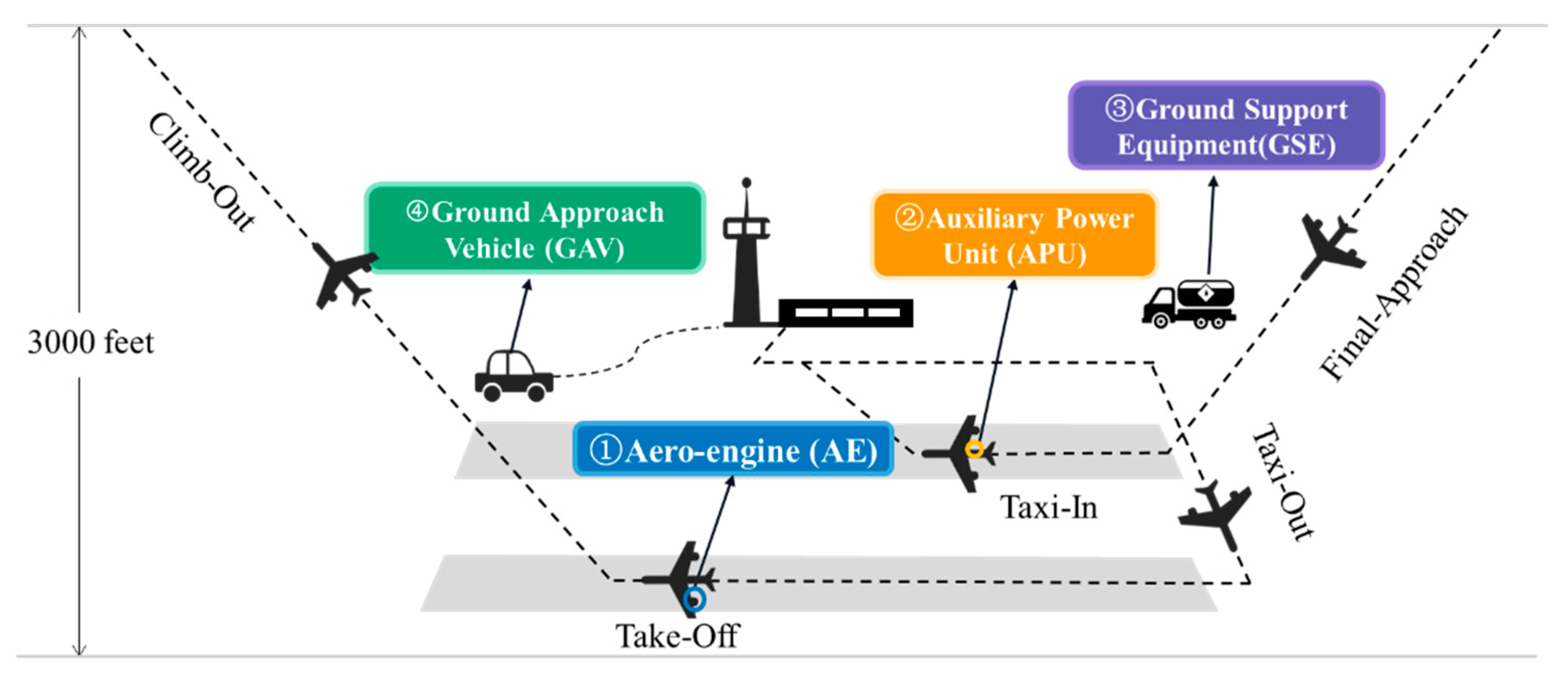
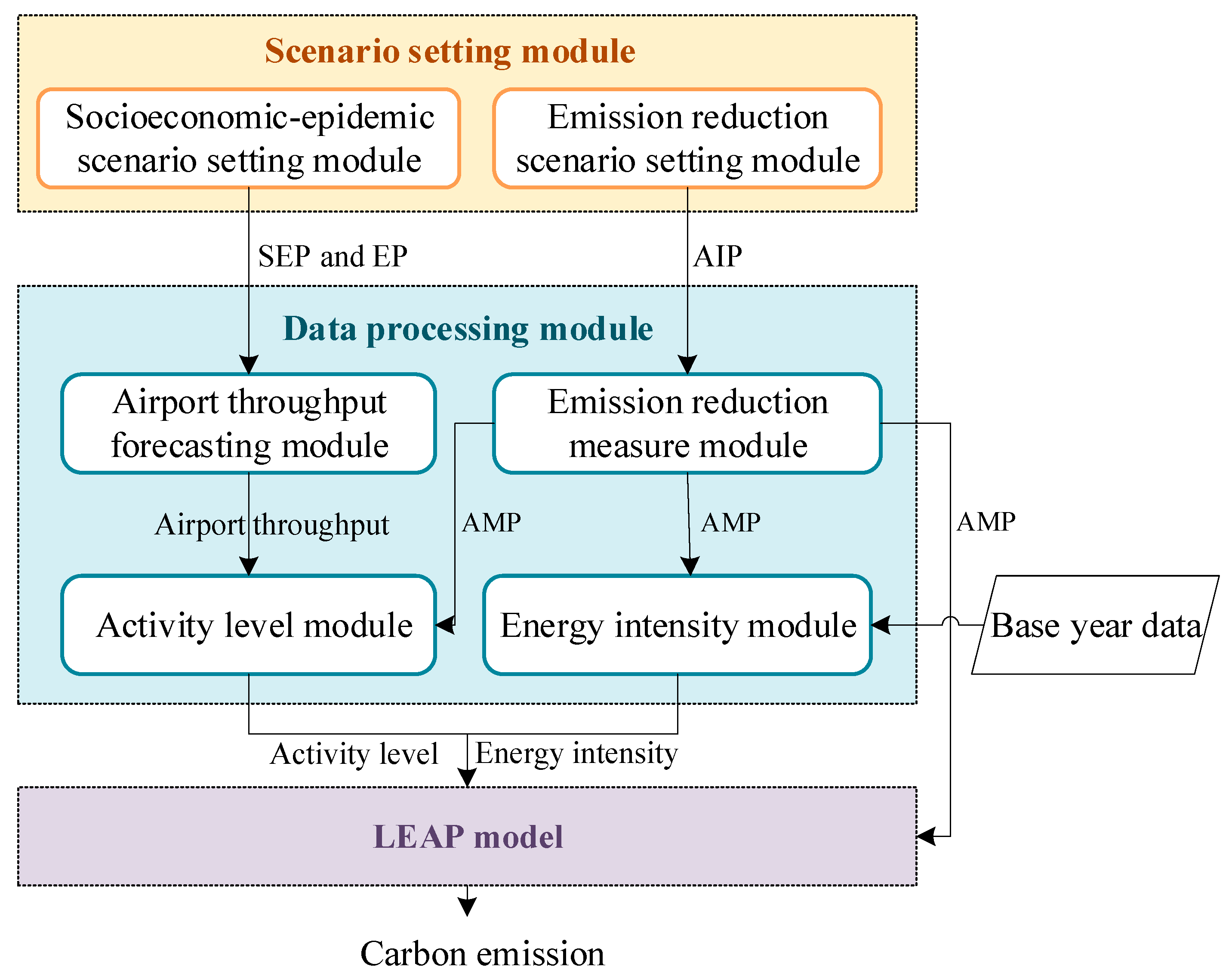
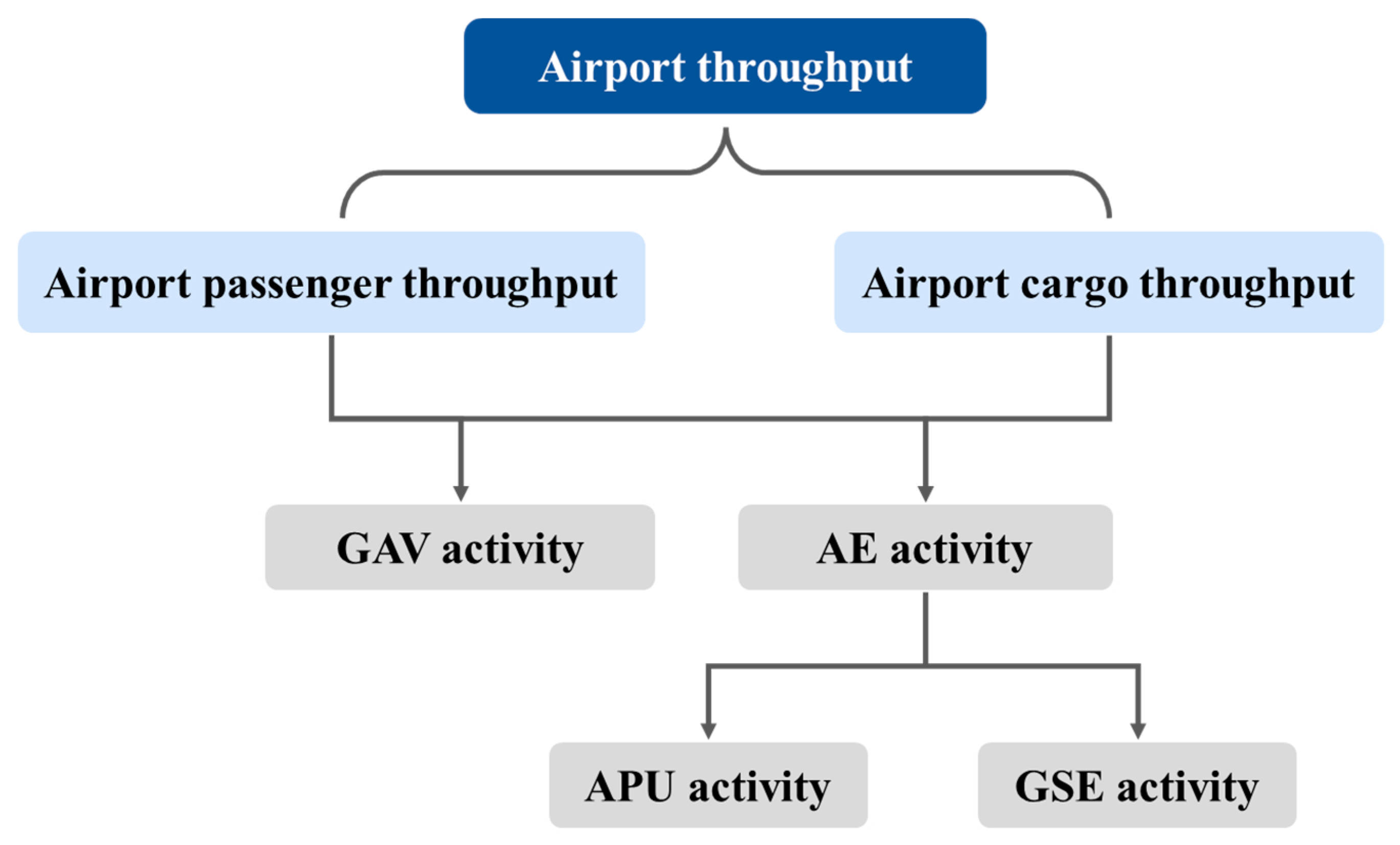

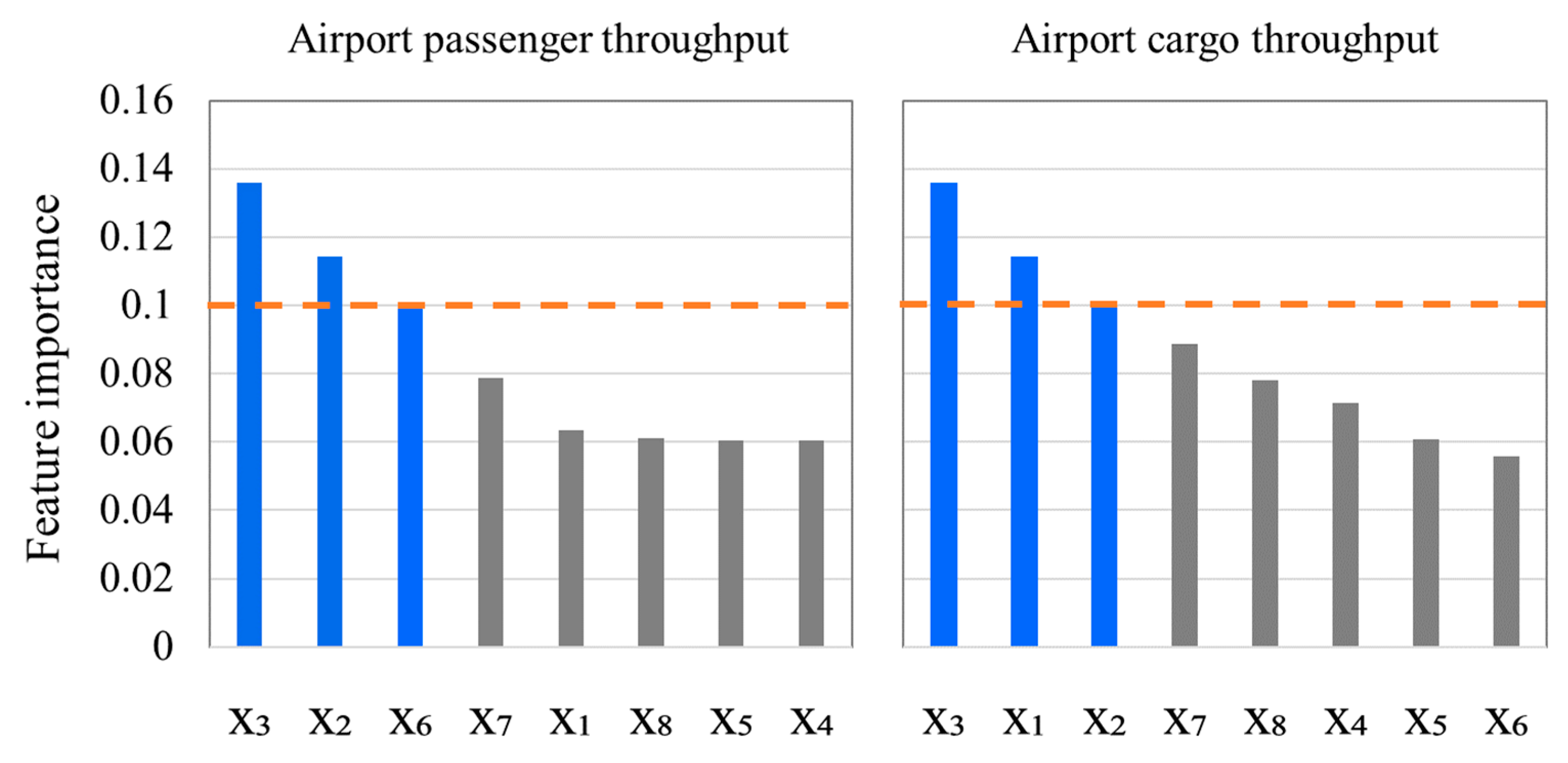
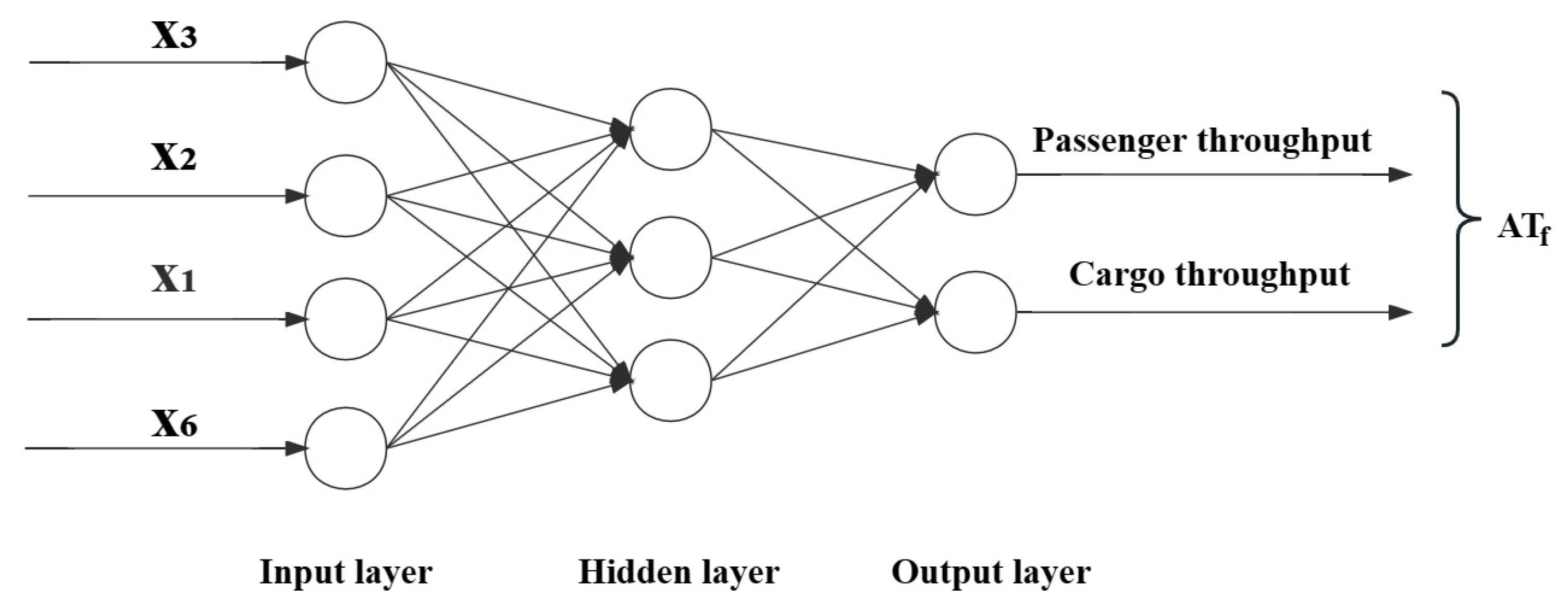
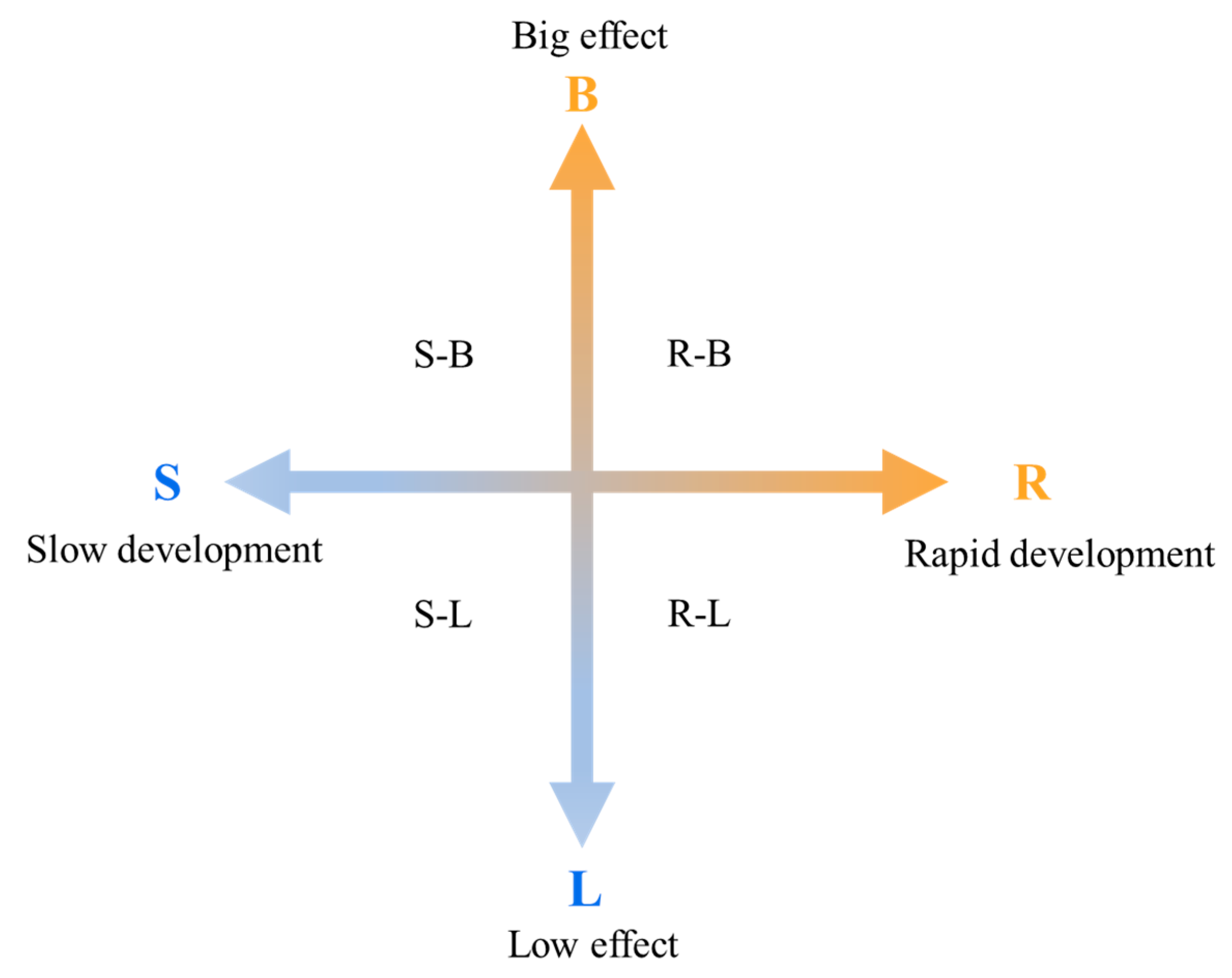
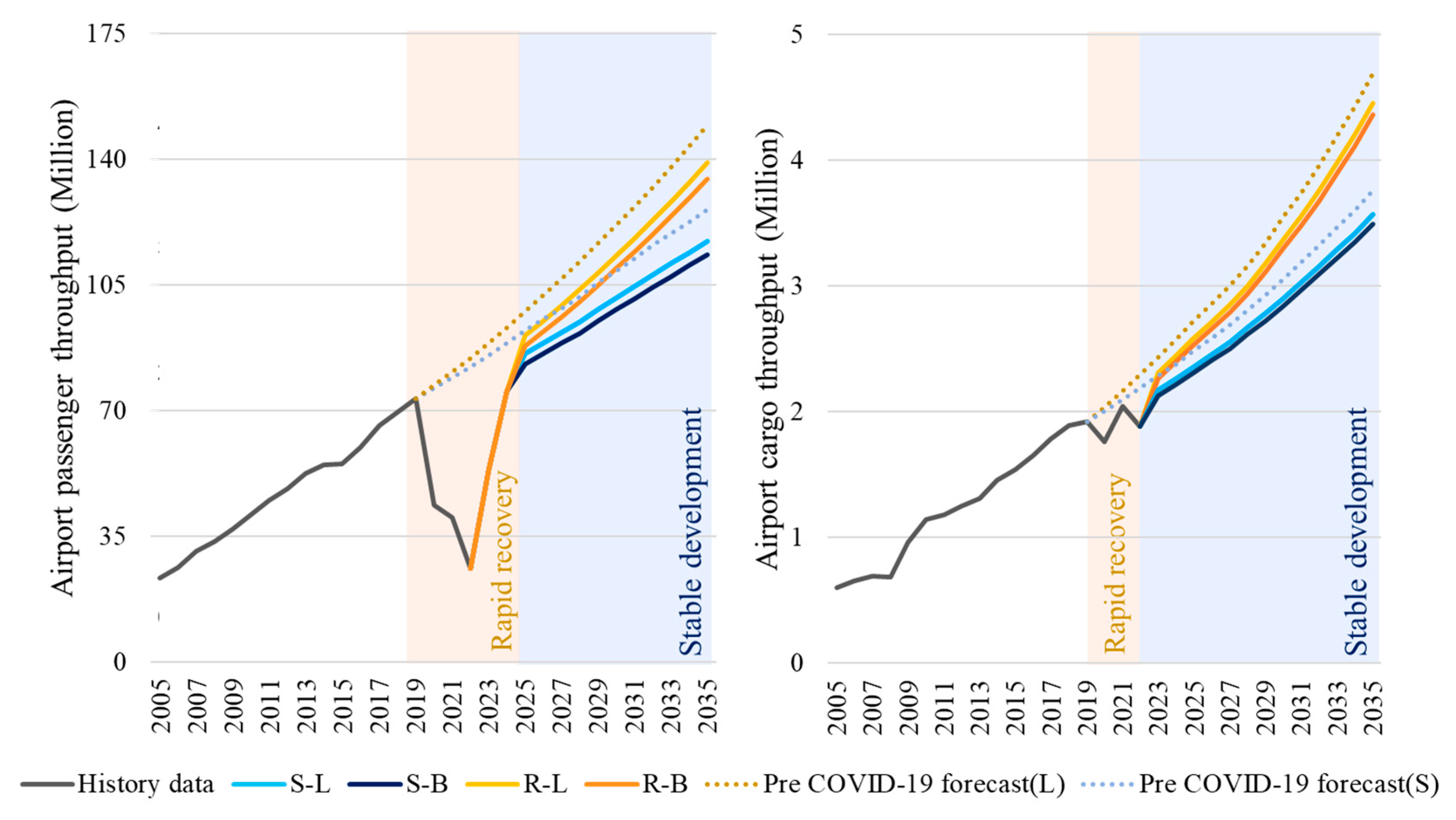

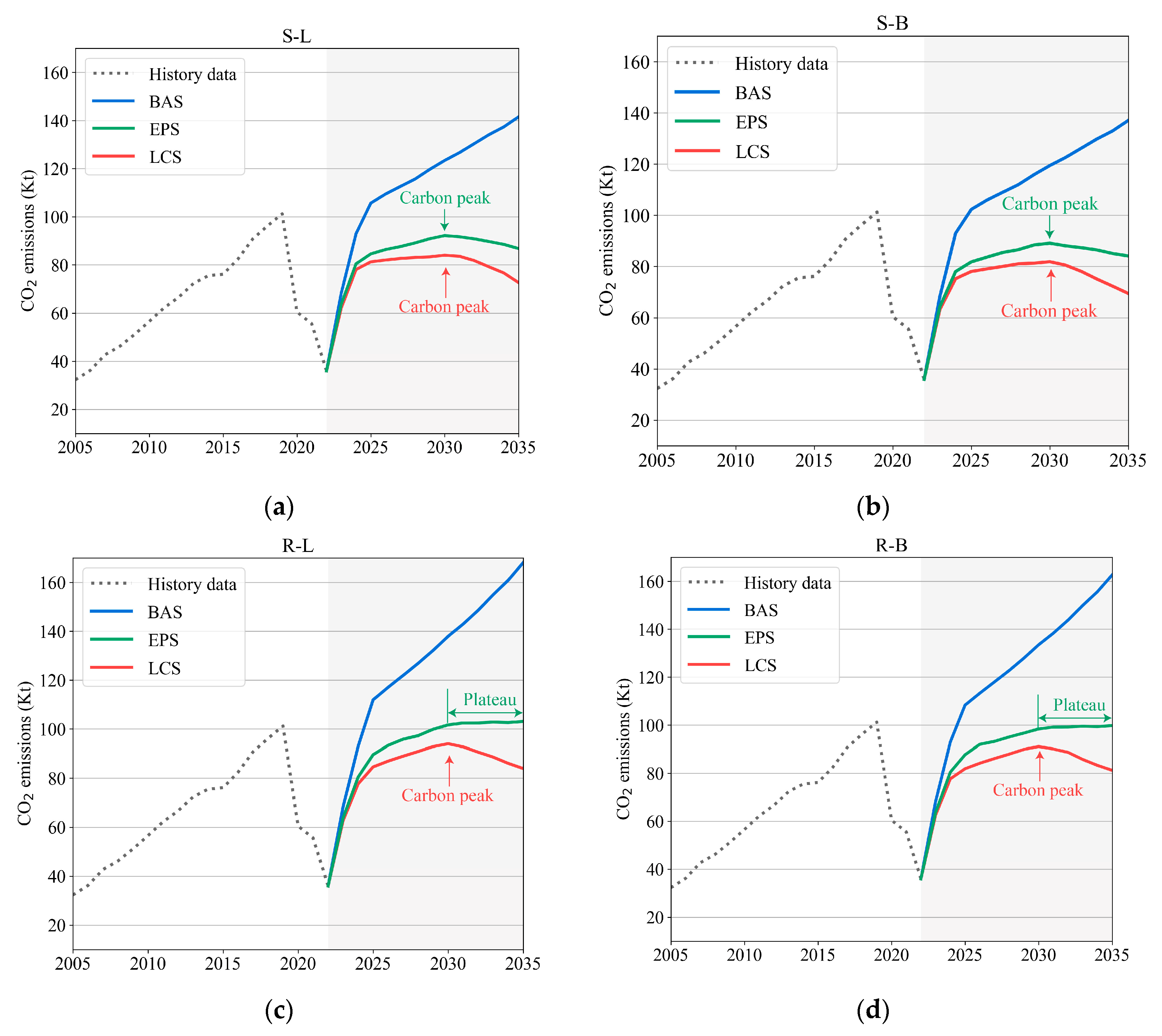
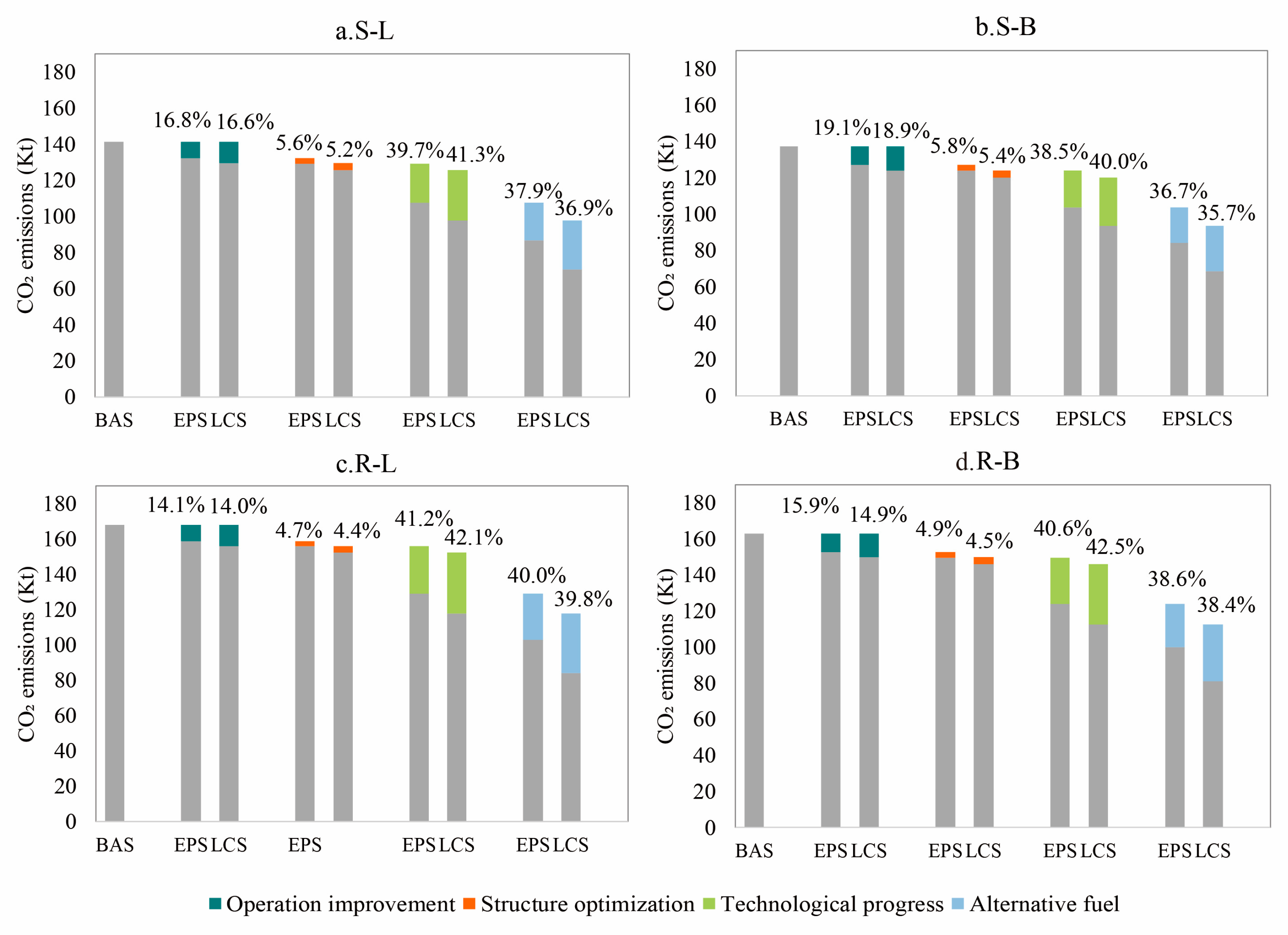
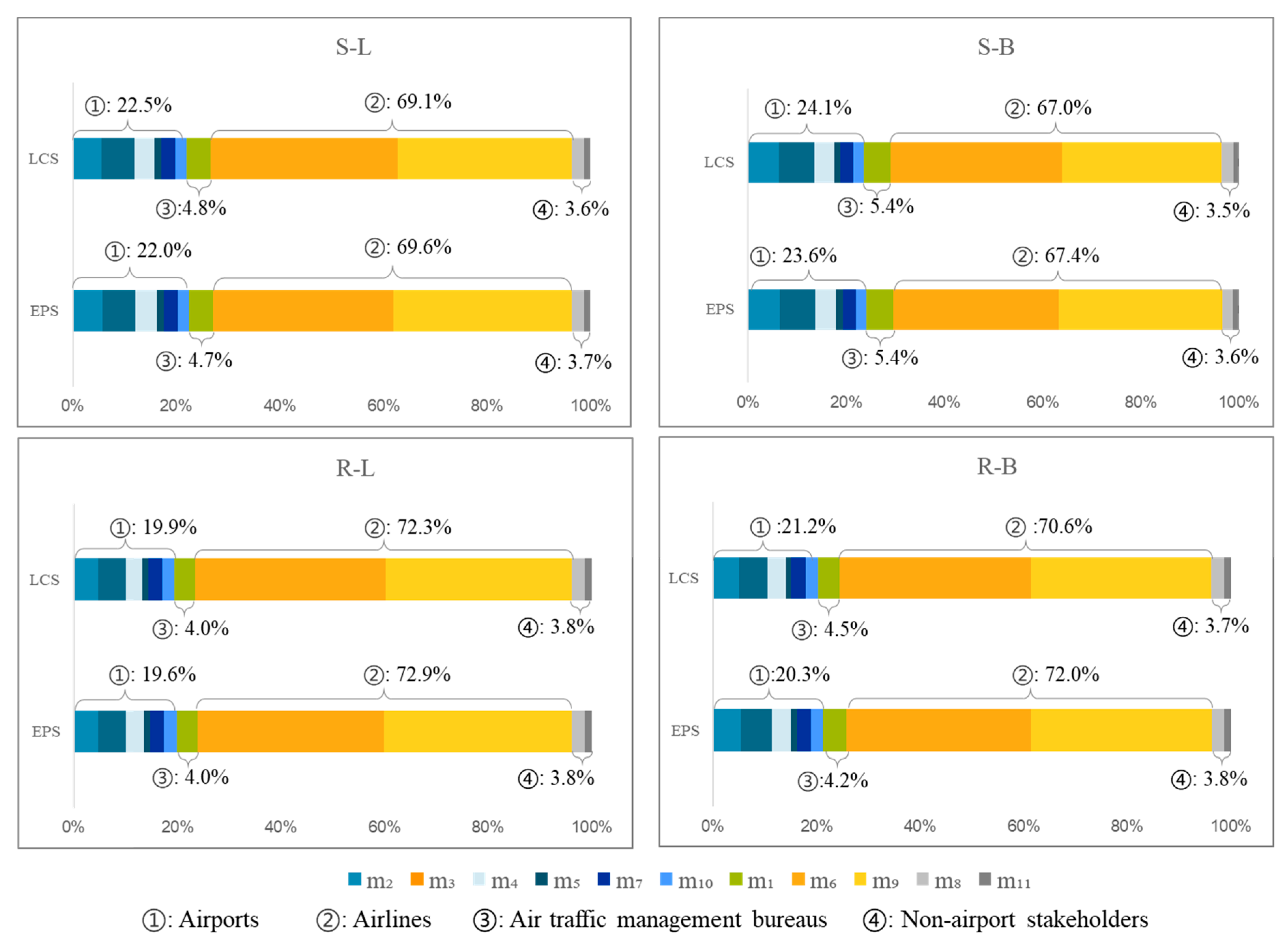
| Emission Sources | Description |
|---|---|
| AE | Engine powered by aviation gasoline or aviation kerosene. |
| APU | Helps start the main engines and provides power when the aircraft is approaching, taxiing, or repositioning on the apron. |
| GSE | Provides corresponding services for the aircraft during arrival and departure so as to ensure the normal operation of the aircraft, including aircraft trailers, air starters, forklifts, etc. |
| GAV | Drives in and out of the airport to pick up and drop off passengers, mainly including private cars, taxis, and airport buses. |
| Sector | Subsector | End-Use | Device | |
|---|---|---|---|---|
| Airport | AE | Passenger aircraft engine | Wide-body passenger aircraft engine | Jet fuel, sustainable aviation fuels (SAFs) |
| Narrow-body passenger aircraft engine | ||||
| Regional aircraft engine | ||||
| Cargo aircraft engine | Wide-body cargo aircraft engine | |||
| Narrow-body cargo aircraft engine | ||||
| APU | Wide-body aircraft APU | |||
| Narrow-body aircraft APU | ||||
| GSE | Air start | Gasoline, diesel, electricity, hybrid | ||
| Aircraft tractor | ||||
| Baggage tractor | ||||
| Belt loader | ||||
| Cabin service truck | ||||
| Cargo loader | ||||
| Catering truck | ||||
| Fuel truck | ||||
| GPU | ||||
| Hydrant truck | ||||
| Lavatory truck | ||||
| Service truck | ||||
| GAV | Bus | Diesel, electricity, hybrid | ||
| Private car | Gasoline, diesel, electricity, hybrid | |||
| Taxi | Gasoline, electricity, hybrid | |||
| Year | 2023 | 2025 | 2030 | 2035 | ||
|---|---|---|---|---|---|---|
| Average seating rate | 79.81% | 83.90% | 85.50% | 86.50% | ||
| Aircraft type ratio | Wide-body aircraft | 400 seat class | 0.45% | 0.45% | 0.45% | 0.44% |
| 250 seat class | 14.31% | 14.78% | 15.82% | 16.63% | ||
| 350 seat class | 4.98% | 5.04% | 5.14% | 5.14% | ||
| Narrow-bodied aircraft | 120 seat class | 7.43% | 6.37% | 4.29% | 2.83% | |
| 160 seat class | 58.18% | 57.92% | 56.56% | 54.25% | ||
| 200 seat class | 12.38% | 12.69% | 13.35% | 13.78% | ||
| Branch line | 90 seat class | 2.27% | 2.75% | 4.41% | 6.93% | |
| Year | 2023 | 2025 | 2030 | 2035 | |
|---|---|---|---|---|---|
| Average load rate | 60% | ||||
| Aircraft type | Large wide-body aircraft (100 tons) | 34.49% | 32.32% | 28.87% | 25.63% |
| Medium wide-body aircraft (60 tons) | 12.97% | 13.07% | 13.18% | 13.22% | |
| Narrow-body aircraft (30 tons) | 52.54% | 54.61% | 57.95% | 61.15% | |
| Emission Reduction Angle | Measure Name | Serial Number | Emission Source | Subjects Responsible for Emission Reduction |
|---|---|---|---|---|
| Operation Improvement | Optimization of arrival and departure procedures | AE | Air traffic management bureaus | |
| Ground movement optimization | AE | Airports | ||
| Single-engine taxi | AE | Airports | ||
| Structure optimization | APU replacement | APU | Airports | |
| Increase the proportion of passengers arriving by public transit * | GAV | |||
| Technological progress | Improve energy efficiency | AE | Airlines | |
| GSE | Airports | |||
| GAV | Non-airport stakeholders | |||
| Alternative fuel | Use SAFs | AE; APU | Airlines | |
| Electrify or use alternative fuels | GSE | Airports | ||
| Electrify or use alternative fuels | GAV | Non-airport stakeholders |
| Key Socioeconomic Factors | 2023–2025 | 2026–2030 | 2031–2035 | ||||
|---|---|---|---|---|---|---|---|
| Slow | Rapid | Slow | Rapid | Slow | Rapid | ||
| x3 | Urbanization rate (%) | 87.5 | 88.1 | 89.6 | 90.0 | 90.0 | 91.6 |
| x2 | Growth rate of permanent population (%) | 1.4 | 2.4 | 1.2 | 1.8 | 0.4 | 0.8 |
| x1 | Growth rate of GDP (%) | 5.6 | 6 | 5.2 | 5.6 | 4.2 | 4.6 |
| x6 | Growth rate of gross tertiary industry (%) | 6.3 | 6.6 | 5.3 | 5.6 | 4.3 | 4.6 |
| Air Passenger Market | |||
|---|---|---|---|
| Influence degree | Parameters in rapid recovery stage () | Parameters in stable development stage () | |
| 2023 | 2024 | 2025–2035 | |
| Low | 75% | 103% | 93% |
| Big | 90% | ||
| Air Cargo Market | |||
| Influence degree | Stable development stage parameters () | ||
| 2023–2035 | |||
| Low | 95% | ||
| Big | 93% | ||
| Emission Reduction Measures | Parameter | Emission Source | BAS | EPS | LCS | |||||
|---|---|---|---|---|---|---|---|---|---|---|
| 2023–2035 | 2025 | 2030 | 2035 | 2025 | 2030 | 2035 | ||||
| Operation improvement | Arrival and departure procedures optimize permeability | AE | - | 20% | 100% | 100% | 40% | 100% | 100% | |
| Ground movement optimization permeability | AE | - | 50% | 10% | 20% | 60% | 20% | 30% | ||
| Single-engine taxi permeability | AE | - | 58% | 68% | 73% | 63% | 73% | 78% | ||
| Structure optimization | APU replacement rate | APU | 86% | 90% | 95% | 100% | 95% | 100% | 100% | |
| Increase the proportion of passengers arriving by public transit | Proportion of airport bus arrivals | GAV | 26% | 28% | 30% | 32% | 30% | 32% | 34% | |
| Proportion of subway arrivals | - | 30% | 35% | 45% | 50% | 40% | 50% | 55% | ||
| Technological progress | Energy efficiency improvement rate | AE | - | 1% | 2% | |||||
| GSE | - | 2% | 4% | |||||||
| GAV | - | 2% | 4% | |||||||
| Alternative fuel | Share of SAFs | AE, APU | - | 1.8% | 6.4% | 12.8% | 2% | 8.4% | 16.8% | |
| Electrify or use alternative fuels | Conventional fuel | GSE | 76% | 65% | 57% | 50% | 55% | 47% | 40% | |
| Hybrid | GSE | 8% | 10% | 13% | 15% | 15% | 18% | 20% | ||
| Electric | GSE | 16% | 25% | 30% | 35% | 30% | 35% | 40% | ||
| Electrify or use alternative fuels | Conventional fuel | GAV | 95% | 72% | 59% | 52% | 65% | 52% | 45% | |
| Hybrid | GAV | 1% | 10% | 13% | 15% | 15% | 18% | 20% | ||
| Electric | GAV | 4% | 18% | 28% | 33% | 20% | 30% | 35% | ||
| Socioeconomic–Epidemic Scenario | Emission Reduction Scenario | Uncertain Scenario of Airport Development |
|---|---|---|
| S-L | BAS | S-L-BAS |
| EPS | S-L-EPS | |
| LCS | S-L-LCS | |
| S-B | BAS | S-B-BAS |
| EPS | S-B-EPS | |
| LCS | S-B-LCS | |
| R-L | BAS | R-L-BAS |
| EPS | R-L-EPS | |
| LCS | R-L-LCS | |
| R-B | BAS | R-B-BAS |
| EPS | R-B-EPS | |
| LCS | R-B-LCS |
Disclaimer/Publisher’s Note: The statements, opinions and data contained in all publications are solely those of the individual author(s) and contributor(s) and not of MDPI and/or the editor(s). MDPI and/or the editor(s) disclaim responsibility for any injury to people or property resulting from any ideas, methods, instructions or products referred to in the content. |
© 2023 by the authors. Licensee MDPI, Basel, Switzerland. This article is an open access article distributed under the terms and conditions of the Creative Commons Attribution (CC BY) license (https://creativecommons.org/licenses/by/4.0/).
Share and Cite
Ye, W.; Wan, L.; Wang, Z.; Ye, W.; Chen, J.; Lv, Y.; Shan, Z.; Wang, H.; Jiang, X. Medium- and Long-Term Prediction of Airport Carbon Emissions under Uncertain Conditions Based on the LEAP Model. Sustainability 2023, 15, 15409. https://doi.org/10.3390/su152115409
Ye W, Wan L, Wang Z, Ye W, Chen J, Lv Y, Shan Z, Wang H, Jiang X. Medium- and Long-Term Prediction of Airport Carbon Emissions under Uncertain Conditions Based on the LEAP Model. Sustainability. 2023; 15(21):15409. https://doi.org/10.3390/su152115409
Chicago/Turabian StyleYe, Wenjing, Lili Wan, Zhan Wang, Wenhui Ye, Jinhui Chen, Yangyang Lv, Zhanpeng Shan, Huazhong Wang, and Xinyue Jiang. 2023. "Medium- and Long-Term Prediction of Airport Carbon Emissions under Uncertain Conditions Based on the LEAP Model" Sustainability 15, no. 21: 15409. https://doi.org/10.3390/su152115409
APA StyleYe, W., Wan, L., Wang, Z., Ye, W., Chen, J., Lv, Y., Shan, Z., Wang, H., & Jiang, X. (2023). Medium- and Long-Term Prediction of Airport Carbon Emissions under Uncertain Conditions Based on the LEAP Model. Sustainability, 15(21), 15409. https://doi.org/10.3390/su152115409








